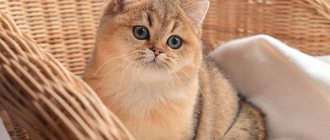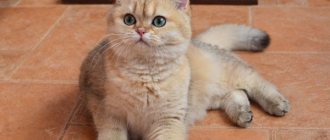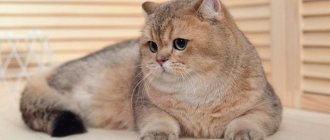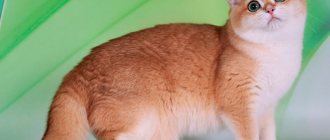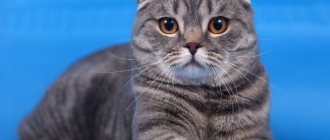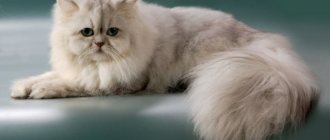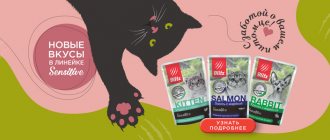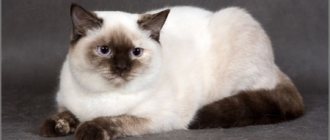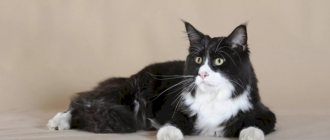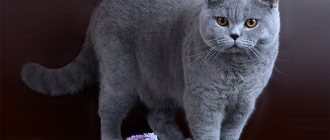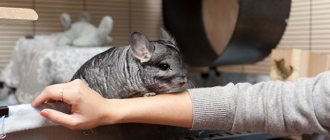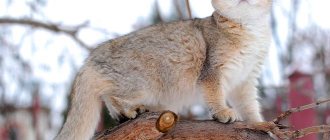The Golden Chinchilla is a cat of an original and rare color, which is most common among the British, Scots and Persians. It was bred artificially by crossing representatives of different breeds.
These animals are extremely popular and invariably win “feline beauty” competitions. But in order to find a purebred pure golden chinchilla kitten, you need to learn about its characteristics and standard requirements.
History of the unique color
The first golden chinchilla kittens were born in a litter of silver chinchilla Persian cats. Breeders were interested in the unusual coloring, but were unable to find the gene responsible for it.
This is interesting. Silver chinchillas have a white coat, and the darkened ends of the hair create the effect of a thrown veil.
Experts decided that the golden pigment appears as a result of the interaction of a whole group of genes. And then the breeders began targeted selection to consolidate the desired trait in the genotype of the animals.
British golden chinchilla cats were bred in the UK. They were created by crossing a Golden Persian and a Smoky Briton. As a result of systematic work, a cat named Silver Lambkin appeared in 1889, who was recognized as the ancestor of this variety.
A little later, Scottish cats began to be crossed with Golden Persians and the British. Animals of this color looked very impressive.
This is interesting. Golden chinchilla cats are often called royal or royal.
Genetics of color
A polygenic complex is responsible for the golden chinchilla color, providing a warm shade of the undercoat and a lightened background color:
- melanin inhibitor – absorbs hair pigment, starting from the hair root;
- agouti and tabby (tabby) - forms a pattern;
- erizer – gene eraser, gives the undercoat a warm shade.
The golden chinchilla color includes several varieties depending on the color of the hair tips:
- black;
- chocolate;
- lilac;
- faun (fawn);
- cinnamon (cinnamon);
- blue.
The golden color is a recessive trait in relation to the silver color. Kittens of this color can be obtained in the following cases:
- both manufacturers have a golden color;
- parents are silver chinchillas, but are carriers of the golden gene;
- one producer is golden, the second is silver, but his genotype contains genes for goldenness.
Characteristics and color features
Regardless of the breed, chinchilla cats should have hair with a smooth color transition from soft pink to dark at the tips. The undercoat can be of different shades: from light peach to red. There should be no dull or grayish areas on the body.
The color is considered chinchilla if the dark tip occupies 1/8 of the length of the hair. If 1/3 is painted, the color is called shaded, if 1/2 is called golden tabby.
In chinchillas, the pigmentation of the iris is usually green or bluish-green. There is a dark brown or black edging on the eyelids, lips and nose. The lobe is colored pink, the paw pads are black or brown.
Information about the breed and color of the cat is indicated in the pedigree. Special designations are used for this.
Breed:
- BRI - British;
- PER – Persian;
- SFL – Scots Fold Shorthair;
- SFS – long-haired Scots Fold;
- SCS – Scots with erect ears, shorthair;
- SCL – long-haired, erect-eared Scotsman.
Color:
- y – golden;
- a – blue;
- b – chocolate;
- c – lilac;
- n – black;
- o– cinnamon;
- q – faun.
Picture code:
- 11 – shaded;
- 12 – chinchilla;
- 21 – linx (tabby pattern on the face and paws);
- 22 – marble;
- 23 – brindle;
- 24 – spotted;
- 25 – ticked (each hair has more than two dark zones);
- 33 – point (reminiscent of the Siamese color).
At the end they put numbers indicating eye color:
- 64 – green;
- 61 – blue;
- 62 – yellow.
For example, a Scottish fold short-haired chinchilla of golden color with black tips of hairs and green eyes would be written as follows: SFLny 12 64.
Colors
The main types of color are considered to be golden British and silver variants. But other shades are known, more than 30 in total. The black version of the shade is considered rare: with age, the rich color turns into dark brown or chocolate.
https://youtube.com/watch?v=W32PwxAlPl8%3F
Golden
The British Golden Chinchilla's coat resembles that of an Arctic fox. Fur color is soft peach or cream, reddish. At the end of the hair the shade becomes darker or turns into a bright smoky color. Options for alternating colors:
- Brown.
- Dark grey.
- Ginger.
The tail, ears and sides of the body usually have a richer color. The color should be even, without spots.
Silver
The dominant color of the British Silver Chinchilla is white. The tips of the fur are 80% black. It gives the impression of shimmering silver and shine on the back and tail. A distinctive feature is the pure white undercoat. The British point chinchilla has a very light shade of fur, almost snow-white.
https://youtube.com/watch?v=gCXlPqi7Uww%3F
Ticked
The ticked representative of the breed is evenly covered with alternating stripes: smooth transitions of dark and light shades. On the back the ticking is usually more noticeable.
Shaded
The coat of a shaded chinchilla is 1/3 darker than the main shade. The undercoat, like that of a silver chinchilla cat, is pure white. A rich shaded transition to the chest and tummy is possible. The tail is black at the end.
White
There is an opinion that a variety of silver colors are mistaken for white chinchillas. The owner of an impeccably white coat has a uniform uniform color along the entire length of the coat. The white British chinchilla has a wide range of eye shades: from blue to soft gold.
Golden Chinchilla Standards
For the first time, the golden chinchilla color was included in the standard of Persian cats. Now it is found in many breeds for which the silver chinchilla color is recognized.
Preference is given to cats with a uniform golden undercoat without a gray area at the roots. When the color first appeared, such animals were still used for breeding, but now they are increasingly not allowed to breed.
There is no single standard regulating the color of the golden chinchilla. Experts evaluate animals in accordance with documents approved for a specific breed by the World Cat Federation:
- British cats are stocky, massive and muscular. The head is round, with a wide skull and pronounced cheeks. The ears are small, set wide, and the tips are slightly rounded. The tail is thick and curves upward. The coat is raised, dense and short.
- Scottish - divided into fold-eared (Scottish fold) and straight-eared (straight). The first ones have small ears, the tips hanging forward. The limbs are short and thick. Straights have erect ears and can be small or medium in size. The limbs are slightly longer and lighter.
- Persian - distinguished by rectangular body lines. Legs are strong and short. The head is large, the forehead is sloping (other chinchillas have a rounded forehead).
Golden chinchillas have ears covered with dense and short fur. The eyes are very large and expressive.
Predisposition to diseases
The British Shorthair has a long history, and one of the results of meticulous selection is that these animals have excellent health and excellent disposition. This is a long-lived breed. However, due to crossbreeding with Persian cats, some members of the chinchilla variety sometimes have kidney disease, although this is not common.
Polycystic kidney disease and blood type B
In the 20th century, British Shorthair breeders used Persian cats to create a chinchilla line. Persians are prone to an inherited kidney disease called polycystic kidney disease. Since then, outbreaks of this disease have been periodically reported in the UK.
A more common problem for British cats is the rare blood type that some of these cats have. British Shorthairs can be Type A or Type B. Most have Type A blood. Some have Type B. It is not a blood disorder, and Type B cats are just as healthy as Type A cats. But for breeding purposes or if blood transfusions are needed this must be taken into account. Type A blood will kill a cat with type B blood and vice versa.
British shorthair breeders are worried about blood type due to "fading kitten" syndrome. When the mother cat has type B blood and the father of the kittens has type A blood, their kittens can have both type A and type B blood. Mother's milk contains antibodies to type A, which will kill type A kittens within 72 hours. Fortunately, there is now a DNA test to check the blood type before breeding a cat.
British
British chinchillas are usually smaller. They ripen late - full formation of the exterior is completed by 3 years.
The wool has a soft and silky texture. There are 2 varieties: British shorthair and longhaired chinchillas. The latter have elongated fur, which is inherited from Persian cats.
The most common are golden chinchillas with green eyes, but there are cats with blue and yellowish irises.
Health
Modern felinologists offer several options for the origin of British breed cats with the Golden Chinchilla color. American and British breeders are vying for the lead in the struggle to create the breed.
Despite all the differences in opinions, the fact remains undeniable that pets with a gorgeous golden hue to their skins have good immunity and resistance to adverse environmental factors.
Scottish
The Scottish chinchilla cat has the same color as the British one. She has a plush coat, a dense undercoat of a warm shade, dark lining of the eyelids, lips and nose, and brown paw pads.
The eyes are most often green, but can also be blue. These animals have soft, rounded body shapes, which provide developed muscles and thick hair.
Persian
Persian chinchillas are slightly smaller than their counterparts. They are harmoniously built, distinguished by fine bones and elegance, but at the same time strong and resilient. In the USA, larger cats are bred, which are very similar in size and build to standard Persians.
The coat of Persian golden chinchillas is long and dense. The fur shimmers beautifully in the light. The cat may have emerald or bluish eyes with a brown rim. The soft pink nose is small and neat.
Description
According to the description and main characteristics, the chinchilla fully corresponds to the short-haired representatives of the British breed. The main difference is the luxurious arctic fox fur of an unusual color and dense undercoat.
- British chinchillas have a large, muscular body with a wide chest. The physique is quite powerful, especially in cats; cats are more graceful.
- The breed standard is a large, round head with wide cheekbones and pronounced fluffy cheeks.
- The nose is wide and small, but not flattened, like the Persians. It has a soft pink or dark brown color.
- The ears are small, slightly sloping, and located at a wide distance from each other.
- The neck is short.
- The eyes are set shallowly, but they are quite large in size. Standard eye colors are emerald and blue (cornflower blue).
- Chinchillas' limbs are slightly shorter than those of ordinary British dogs, but they are very proportionate. Sometimes it seems that in appearance cats and cats have too short paws, but in reality this is not the case. This effect is achieved due to light fur and muscular limbs.
- British chinchillas have large paws. The tail is not very long and not fluffy, and has a rounded tip.
- The standard weight of cats is usually no more than 8 kg, for cats it is slightly less: up to 3 or 4 kg. Neutered animals can gain significant weight if they do not eat properly and exercise actively.
- The coat of British chinchillas is very dense, but soft, and the undercoat is very thick. The coat resembles that of an arctic fox.
Due to these interesting external features, which are ideally combined with the snow-white-silver or golden coat of cats, British chinchillas look truly luxurious.
Character and behavior of elite pets
Chinchillas are considered the aristocrats of the cat family. They are distinguished by noble manners, a sharp mind and excellent memory.
The characteristics of golden chinchilla cats are determined by the breed:
Each animal has individual character traits. Therefore, the habits and behavior of pets may differ slightly from the description given.
Temperament
Golden Chinchillas are distinguished by a truly aristocratic temperament and restraint. These pets show dignity and noble manners from a young age. It won't be difficult to train your cat to use the litter box. These fluffies respect the right of their owners to a peaceful morning sleep and are able to satisfy basic needs without disturbing the rest of the family. Representatives of the breed get along well with other inhabitants of the house, including feathered and four-legged residents.
Seals also build harmonious relationships with young residents of their homes. If children bother your furry pet too much, the cat will simply hide in a secluded corner without showing the slightest aggression.
The basic character traits of the breed are stubbornness and independence. The cat reacts with hostility to all attempts by people to limit freedom of movement or move the boundaries of their individual territory.
Features of care and maintenance
Owners of golden chinchilla cats have to comb their luxurious coat at least 2 times a week to keep it tidy. During the molting period, the procedure is carried out daily.
Chinchillas have a two-layer coat. It must be combed in 2 stages: first along the hair growth, then against it. It is recommended to use a fine-toothed comb or a special glove.
Cats are bathed as needed, but not more than once every 3-4 months. Due to frequent washing, the coat becomes dry and brittle. Dry products are used as a replacement for regular shampoos.
Otherwise, care for golden chinchillas is standard:
The pet should have a separate place to rest, a variety of toys and a cat scratching post. Animals quickly learn to use the toilet, but the tray must be large and comfortable, since the golden chinchilla color is found in fairly large breeds.
For your information. Some cats like to walk on a leash or harness. However, most of them are satisfied with being in a confined space - a house or apartment.
Feeding the animals
For feeding golden chinchillas, like other purebred cats, high-quality ready-made food with a protein content of at least 30-35% is suitable. They have a balanced composition and fully satisfy the needs of the animal’s body.
The following brands have proven themselves well:
- 1st Choice;
- Hills;
- Acana;
- Leonardo;
- Sanabelle Bosch;
- Pro Plan.
If the owner chooses a natural diet, then it is based on meat - turkey, chicken, veal. The meat needs to be frozen for 2-3 days. It is given raw, cut into pieces and doused with boiling water. These measures are necessary to destroy parasites and bacteria.
Cats do not refuse offal. Liver, lung, heart, tripe are suitable for feeding. They must be boiled for several hours.
Also included in the diet:
- rice and buckwheat porridges;
- boiled sea fish fillet (if you have problems with the genitourinary system, this product is excluded);
- boiled vegetables (zucchini, carrots, pumpkin, cauliflower);
- egg yolk (no more than 2 times a week);
- fermented milk products with low fat content (kefir, yogurt, cottage cheese, natural yogurt).
Pets are fed 2-3 times a day. Food from the human table is contraindicated for animals.
Important. The structure and appearance of the coat directly depend on the quality of nutrition. Errors in feeding lead to dull and brittle fur and prolonged molting.
Possible diseases
The health of cats directly depends on heredity; immunity is passed on from the parents. In general, chinchillas are in good health, but may be prone to certain diseases.
Retinal atrophy is damage to light-sensitive receptors in the retina of the eye. Symptoms include dilated pupils, shiny eyes, and sudden onset night blindness. The animal stops seeing in the dark, and in advanced cases can completely lose vision. Unfortunately, there is no effective treatment for atrophy
It is important to maintain eye hygiene to prevent dirt from accumulating on them.
Caries. For prevention, it is important to brush your teeth, and if caries is detected, contact your veterinarian immediately.
Hypertrophied cardiopathy is a heart disease in which the wall of the ventricle thickens
May cause the cat to develop heart failure or thromboembolism. It can only be detected using ultrasound. At the beginning of the disease, the animal may notice shortness of breath and fatigue. Timely diagnosis and timely treatment begin guarantee a favorable outcome.
Polycystic kidney disease is a disease of the genitourinary system in which cysts appear in the kidneys. It is very difficult to recognize the manifestations of the disease at the initial stage, but still, if it is possible, then surgical removal of the cyst is performed. But most often, symptoms become noticeable only when the formations greatly increase in size and the cat experiences pain. If cysts are detected by simple palpation of the abdominal cavity, then the operation is pointless. It is no longer possible to save the animal, since the kidneys cannot function normally. Only a special diet and drug therapy prescribed by a veterinarian can alleviate suffering. They will be able to extend the life of the pet.
How much does a royal chinchilla cost?
Pure golden color is quite rare. More often you can see kittens having the so-called halftone. In the metrics that are issued at 1.5 months, they are often noted as golden chinchillas. But after molting, which takes place in 5-8 months, the color changes.
For people who have a kitten as a pet, these nuances do not matter. But for those who breed or plan to participate in exhibitions, color purity is very important.
To avoid misunderstandings, you should:
- carefully study the requirements for color and its features;
- read reviews about breeders offering such animals;
- meet the kittens’ parents and evaluate their compliance with the standard.
Due to the difficulty of obtaining a color, a kitten is quite expensive:
- British chinchillas: pet class - 25 thousand rubles, show class - about 50-70 thousand rubles;
- Scottish and Persian cats: pet class - 12-25 thousand rubles, show class - from 35 thousand rubles.
Purebred kittens can be purchased at a specialized nursery or from a reputable breeder who breeds animals of this particular color.
Important. Finding a rare pet from an ad on the Internet is almost impossible. Chinchillas are bred only through competent breeding work.
There is a common misconception that there is an independent breed of golden chinchilla cats. Because of this, confusion often arises. For example, people who count on an easy-going Briton end up with wayward Scots. Therefore, it is so important to first find out all the nuances, and only then get a pet.
Golden chinchilla cats are very rare, unusually beautiful and intelligent animals. These are real fluffy “suns”, a find for lovers of luxury and chic.
How to choose?
When choosing a golden kitten, you need to decide on the following points:
- the character traits of which breed appeal more;
- a kitten is purchased only for an adult or for a family with a child;
- readiness for everyday care;
- Is the chinchilla expected to live in the house with other representatives of the fauna?
For adults who have no other pets in their home, of course, you can choose any kitten you like based on suitable characteristics and preferred color. Families with small children or other animals are better off choosing the Scottish breed.
It is better to get a Persian chinchilla for those families where children have already reached the age of 10, as it behaves warily towards small children
If suddenly the baby persistently shows attention to the cat at a moment when it is not in the mood, then it may show aggression: hiss intimidatingly, scratch or bite
When purchasing, it is important to find out the availability of vaccinations, and, if possible, study documents related to the pedigree
In addition, you should take into account the fact that babies up to 3 months can be tabby in color, but as the cat gets older, it will become more uniform. Therefore, many responsible breeders do not sell kittens under three months of age, but give them the opportunity to spend longer with their mother so that their color, healthy psyche and immunity are finally formed.
